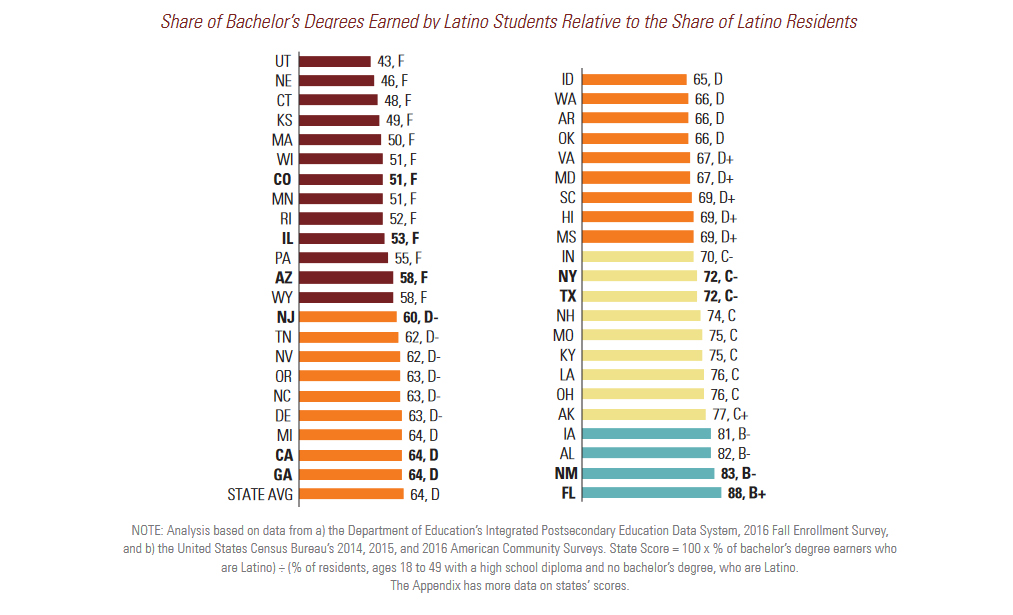
Share On Social!
When it comes to enrolling and graduating Latinos, public colleges and universities in most states are failing, according to new research by The Education Trust.
Latinos are not getting their fair share of seats or degrees from public institutions of higher education in nearly every state when compared with state demographics and White peers. This, at a time when the U.S. Latino population is rising.
Why is this inequity happening?
It’s not about a lack of talent or aspirations among Latinos—it’s the result of “structural racism and injustices throughout the education pipeline” that make it harder to pursue high education, according to the report.
“A college degree is the surest path to the middle class. The fact that Latinos don’t have equitable access to enrolling in college and earning a college degree means millions of Latinos are missing out on the best chance to move into the middle class,” said Wil Del Pilar of The Education Trust, in a news release. “This isn’t just damaging to Latinos. This systematic inequality threatens our democracy and our economy. It’s time for state leaders to act.”
Colleges Are Failing to Enroll Latinos
For their new report, The Education Trust analyzed census and federal higher education data. They wanted to see how well Latinos are represented in public community and technical colleges and four-year colleges and universities.
 They also gave a letter grade to certain categories.
They also gave a letter grade to certain categories.
Key findings show:
Latino students are underrepresented in higher education in most states. In 40 of the 44 states (or 90%) examined, Latino students are underrepresented at community and technical colleges. In 33 of the 44 states (or 75%), Latino enrollment at four-year public institutions is not on par with the state’s proportion of Latino residents.
The states with the largest Latino populations fail to provide Latino students with the same access to selective public four-year institutions as their White peers. Four of the eight states (California, Texas, Florida, and New York) with enrollment gaps of 10 percentage points or more between Latino and White students were states that accounted for more than 61% of the Latino population.
Texas, California, and Florida received an “F” on this measure. New York earned a “D.”
Colleges Are Failing to Graduate Latinos
The Education Trust also examined graduates in each state.
 In all 44 of the states we examined, Latinos are underrepresented among associate and bachelor’s degree earners. Underrepresentation was worse at the bachelor’s degree level in 14 states. These states are home to nearly 68% of the country’s Latinos who do not have a college degree.
In all 44 of the states we examined, Latinos are underrepresented among associate and bachelor’s degree earners. Underrepresentation was worse at the bachelor’s degree level in 14 states. These states are home to nearly 68% of the country’s Latinos who do not have a college degree.
A smaller share of Latino graduates received a bachelor’s degree compared to their White peers in most states. Nine states (Arizona, Colorado, Connecticut, Hawaii, Kansas, Massachusetts, Minnesota, Nebraska, and Texas) have double-digit gaps between the shares of Latino and White graduates who are awarded a bachelor’s degree. In these states, Latino graduates disproportionately receive associate degrees and certificates. These can be less economically valuable than bachelor’s degrees.
The Structural Racism that Holds Latinos Back
The report contends these college deficiencies are due to structural racism.
The Education Trust points out that:
- Latino K-12 students receive far less support than their White peers. “Many attend segregated, high-poverty schools, with less effective and less experienced teachers, low expectations and limited access to advanced coursework, and higher and harsher levels of discipline.”
- College costs are one of the biggest hurdles for Latinos.
- Latinos are also far less likely to have college-educated parents.
- College admissions practices don’t help. “Less than 10 percent of respondents [in a survey of admissions officers] said race is a “considerable” or “moderate” factor in admissions decisions.” That contributes to disparities and limits Latino student access.
- Once admitted, Latinos still may find obstacles. States provide less funding for public colleges that enroll more students of color. Most does to “costly, noncredit, developmental education courses that delay progress toward a degree.”
Reasons for Optimism for Latino Students
On a more positive note, several states with large Latino populations are close to meeting equity benchmarks.
 The Education Trust found that:
The Education Trust found that:
- California, Texas, and Florida have larger Latino populations and scored above the state average on Latino enrollment representation at community and technical colleges.
- Within the public four-year sector, Kentucky, Iowa, Florida, Arkansas, and New York are the highest performers. They have Latino enrollment shares that approach or exceed their population benchmarks. New Mexico has the largest share of Latino residents among the 50 U.S. states (at 53%).
- Several states with a substantial population of Latino residents are in the top 10 for Latino representation among associate degree earners. These include Florida, Texas, New Mexico, New York, and California.
- New Mexico and Florida also stand out for awarding bachelor’s degrees to Latinos in nearly proportional numbers.
Actions to Boost Latino College Enrollment, Graduation
The Education Trust calls on states to act to understand the root causes of Latino enrollment and degree disparities.
They recommend these four immediate actions:
- Set race and ethnicity targets in statewide college degree attainment goals.
- Reward public colleges and universities for enrolling and graduating students of color.
- Ensure residents with some college but no degree are eligible for need-based aid programs.
- Invest in community college programs that help residents earn high school equivalency credentials and get on a pathway to higher education.
“For starters, every state in the country should set measurable race and ethnicity targets as part of statewide college degree attainment goals,” said Del Pilar. “States should reward colleges for enrolling and graduating students of color in performance funding formulas.”
Other Ways to Help
Here are some other ways to help:
- Offer a short task with the power to sharply increase Latino middle-schoolers’ chances of getting to college.
- Provide college for Latino students who don’t have a high-school diploma.
- Create college readiness programs in high school.
- Support Hispanic-Serving Institutions, which are on the rise.
- Recognize colleges that are committed and able to help Latino students find success.
Del Pilar and others suggest states invest in community college programs that help residents earn a high school equivalency credential and get on a pathway to higher education.
“States must do better in serving Latino students when it comes to access and success in public higher education,” said Arturo Vargas, Chief Executive Officer of NALEO Educational Fund. “NALEO Educational Fund will continue to work towards this goal by supporting Latino elected and appointed officials as they develop and enact policies to improve academic opportunity and success among our community.”
Explore More:
EducationBy The Numbers
142
Percent
Expected rise in Latino cancer cases in coming years



